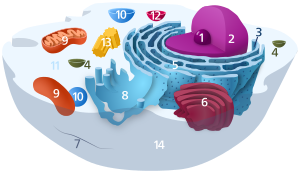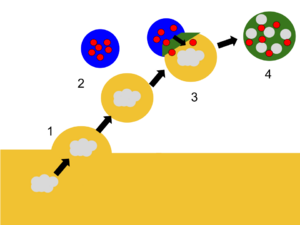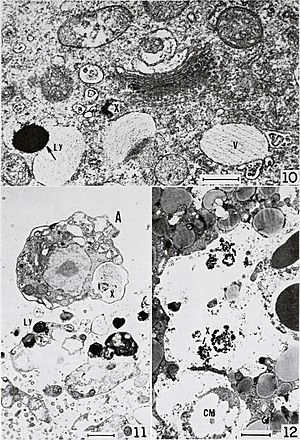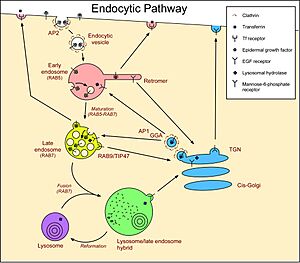Lysosome facts for kids
Quick facts for kids Cell biology |
|
|---|---|
| Animal cell diagram | |

Components of a typical animal cell:
|
A lysosome is a tiny part found inside many animal cells. Think of it like a small, round bag with a special skin (called a membrane) around it. Inside, lysosomes hold powerful tools called enzymes. These enzymes are like tiny scissors that can break down many kinds of biomolecules, which are the building blocks of life.
The inside of a lysosome is quite acidic, like your stomach. This acidic environment is perfect for the enzymes to do their job. Besides breaking things down, lysosomes also help with other cell jobs. They help the cell release substances, fix its outer skin (the plasma membrane), and even play a small part in cell "cleanup" (called apoptosis). They also help with cell signaling and how the cell gets energy.
Lysosomes act like the cell's recycling and waste disposal system. They break down used materials from both inside and outside the cell. Materials from outside the cell are brought in through a process called endocytosis. Materials from inside the cell are cleaned up through a process called autophagy. Lysosomes can be different sizes; some are much larger than others. They were discovered by a Belgian scientist named Christian de Duve, who won a Nobel Prize in 1974 for his work.
Lysosomes contain over 60 different types of enzymes and more than 50 proteins in their membrane. These enzymes are made in another part of the cell called the rough endoplasmic reticulum. They then travel to the Golgi apparatus. From there, they are sent to the lysosomes in small packages called vesicles. These enzymes have a special tag, a molecule called mannose 6-phosphate, which makes sure they go to the right place.
Scientists discovered in 2009 that a special protein called TFEB helps control the making of many lysosomal enzymes and membrane proteins. If there are problems (called mutations) in the genes for these enzymes, it can cause over 50 different human genetic disorders. These are known as lysosomal storage diseases. In these diseases, certain substances build up in the cell because the lysosomes can't break them down properly. These problems are linked to brain disorders, cancers, heart diseases, and problems related to aging.
Contents
What are Lysosomes?
The name lysosome comes from two old words. "Lyso-" means "to loosen" or "to break down," and "-some" means "body." So, a lysosome is a "body that breaks down" or a "lytic body." The word used to describe things related to lysosomes is lysosomal.
How Lysosomes Were Discovered
Christian de Duve and his team in Belgium were studying how insulin works in liver cells. In 1949, they focused on an enzyme called glucose 6-phosphatase, which is important for how the body uses sugar. They thought this enzyme helped control blood sugar levels. But they had trouble separating this enzyme from other cell parts.
So, they tried a harder method called cell fractionation. This method separates cell parts based on their size using a machine called a centrifuge. They found the enzyme activity in a part of the cell called the microsomal fraction. This was a big step in finding lysosomes by accident.
To check their results, they used another enzyme called acid phosphatase. They noticed something strange: the activity of this enzyme was much lower than expected. One day, they measured the enzyme activity from cell parts that had been kept in the fridge for five days. Surprisingly, the enzyme activity was much higher, back to normal!
They repeated this many times and got the same result. This made them realize that a membrane (like a skin) was blocking the enzyme from reaching what it needed to break down. After a few days, the enzymes could get out and work. They described this as a "sac-like structure surrounded by a membrane and containing acid phosphatase."
It became clear that this enzyme came from a special cell part. In 1955, De Duve named these parts "lysosomes" because of their digestive abilities. That same year, another scientist, Alex B. Novikoff, visited de Duve's lab. He took the first pictures of the new organelle using an electron microscope. De Duve won the Nobel Prize in Physiology or Medicine in 1974 for this important discovery.
De Duve first called lysosomes "suicide bags" because he thought they played a big role in cell death. However, scientists later found that they only have a small part in this process.
Lysosome Jobs and Structure
Lysosomes have many different enzymes. These enzymes allow the cell to break down various biomolecules it takes in. This includes peptides (parts of proteins), nucleic acids (like DNA), carbohydrates (sugars), and lipids (fats). These enzymes work best in an acidic environment.
Besides breaking down small molecules, lysosomes can also join with other cell parts. They can digest large structures or damaged cell pieces. For example, they work with phagosomes to clean out damaged parts of the cell through autophagy. They also help break down viruses or bacteria that are eaten by certain immune cells called macrophages.
Lysosomes vary in size, from very tiny to a bit larger. Their inside is acidic (pH around 4.5–5.0), while the rest of the cell's fluid (called cytosol) is slightly basic (pH 7.2). The lysosomal membrane acts like a shield. It protects the rest of the cell from the powerful enzymes inside the lysosome. If any enzymes leak out, they don't work well in the less acidic cytosol. This keeps the cell safe from accidental damage.
Lysosomes keep their acidic environment by pumping in special particles called protons (H+ ions) from the cytosol. They use special pumps and channels to do this. This constant pumping keeps the inside of the lysosome acidic.
Lysosomes get their amazing ability to break things down by bringing in different enzymes. Each enzyme is good at breaking down a specific type of molecule. For example, cathepsins are a main group of enzymes that break down proteins. Other enzymes break down carbohydrates or remove phosphate groups from fats. Recent studies also show that lysosomes can store and release calcium, which is important for cell signals.
How Lysosomes are Made
Many parts of animal cells are recycled. This happens by moving them inside or embedding them in pieces of membrane. For example, in endocytosis, a part of the cell's outer membrane pinches off to form small sacs called vesicles. These vesicles eventually join with other parts inside the cell. Without new membrane being made, the cell's outer skin would keep shrinking. Scientists think that lysosomes are part of this constant exchange of membranes and grow from other cell parts called endosomes.
The making of lysosomal proteins helps keep lysosomes going. The instructions for making these proteins are found in the nucleus. A protein called TFEB controls this process. The instructions (mRNA) then leave the nucleus and go to the ribosomes in the cytosol. Here, the proteins are built. These new proteins then move into the endoplasmic reticulum, where they are changed.
Special packages (called COPII-coated vesicles) carry the lysosomal proteins from the endoplasmic reticulum to the Golgi apparatus. In the Golgi, a specific tag, mannose 6-phosphate, is added to these proteins. This tag is very important because it helps make sure the proteins are packed into the right vesicles that are heading for the lysosomal system.
After leaving the Golgi apparatus, the vesicles full of lysosomal enzymes join with a late endosome. This endosome is also acidic. The acidic environment makes the lysosomal enzymes separate from their tags. The enzymes are then packed into new vesicles and sent to existing lysosomes. Over time, the late endosome itself can grow and become a mature lysosome.
Protecting Against Germs
Since lysosomes are the final stop for materials brought into the cell, they also act as a defense. They help stop harmful germs (pathogens) from reaching the cell's inside before being destroyed. Germs often try to sneak into cells using the cell's own entry ways, like pinocytosis. The lysosome stops them by breaking down the parts of the germs they need to survive and multiply. If lysosomes don't work well, it can lead to more viral infections, including HIV. Some toxins, like cholera toxin, can also trick the cell's entry system and avoid being broken down by lysosomes.
Health Problems
Lysosomes are involved in a group of inherited diseases called lysosomal storage diseases (LSDs). These are genetic problems where one of the lysosomal enzymes doesn't work correctly. About 1 in 5,000 babies are born with an LSD, but the actual number might be higher because some cases are not diagnosed. The main cause is a missing or faulty enzyme. Other problems can be due to issues with proteins in the lysosomal membrane that fail to move the enzymes.
When these enzymes don't work, specific molecules build up inside the cell's recycling system. This leads to problems with cell signals, how the cell handles calcium, how fats are made and broken down, and how things move around inside the cell. These problems can cause various disorders. The brain, internal organs, bones, and cartilage are often most affected.
There is no direct cure for LSDs. The most common LSD is Gaucher's disease. This happens when an enzyme called glucocerebrosidase is missing. As a result, a fatty substance called glucosylceramide builds up, especially in white blood cells. This can affect the spleen, liver, kidneys, lungs, brain, and bone marrow. Symptoms include bruises, tiredness, low blood iron (anaemia), low blood platelets, weak bones (osteoporosis), and enlarged liver and spleen. As of 2017, there is a treatment called enzyme replacement therapy for 8 of the 50-60 known LSDs.
The most serious and rare lysosomal storage disease is inclusion cell disease. Metachromatic leukodystrophy is another LSD that affects how certain fats (sphingolipids) are handled.
Problems with lysosome activity are also strongly linked to aging and age-related diseases. These include Alzheimer's disease, Parkinson's disease, and heart and blood vessel diseases.
Different Enzymes in Lysosomes
| Number | Enzyme Type | What it Breaks Down |
|---|---|---|
| 1 | Phosphates | |
| A- Acid phosphatase | Most phosphate-containing molecules | |
| B- Acid phosphodiesterase | Small DNA/RNA pieces and other phosphate bonds | |
| 2 | Nucleases | |
| A- Acid ribonuclease | RNA | |
| B- Acid deoxyribonuclease | DNA | |
| 3 | Enzymes Breaking Down Sugars/Complex Sugars | |
| A- β-Galactosidase | Galactose-containing sugars | |
| B- α-Glucosidase | Glycogen (stored sugar) | |
| C- α-Mannosidase | Mannose-containing sugars, glycoproteins | |
| D- β-Glucuronidase | Complex sugars (polysaccharides and mucopolysaccharides) | |
| E- Lysozymes | Bacterial cell walls and complex sugars | |
| F- Hyaluronidase | Hyaluronic acids, chondroitin sulfates | |
| H- Arylsulphatase | Organic sulfates | |
| 4 | Proteases | |
| A- Cathepsin(s) | Proteins | |
| B- Collagenase | Collagen (a protein in connective tissue) | |
| C- Peptidase | Peptides (small protein pieces) | |
| 5 | Fat-Degrading Enzymes | |
| A- Esterase | Fatty acid esters (types of fats) | |
| B- Phospholipase | Phospholipids (fats in cell membranes) | |
| 6 | Sulfatases | |
| A- Arylsulfatase (A, B & G) | O- and N-Sulfate esters | |
| B- Glucosamine (N-acetyl)-6-Sulfatase/GNS | Glycosaminoglycans (complex sugars) | |
| C- Iduronate 2-Sulfatase/IDS | O- and N-Sulfate esters |
See also
 In Spanish: Lisosoma para niños
In Spanish: Lisosoma para niños
- Peroxisome
- Cathelicidin
- Antimicrobial peptides
- Innate immune system
- TMEM106B




